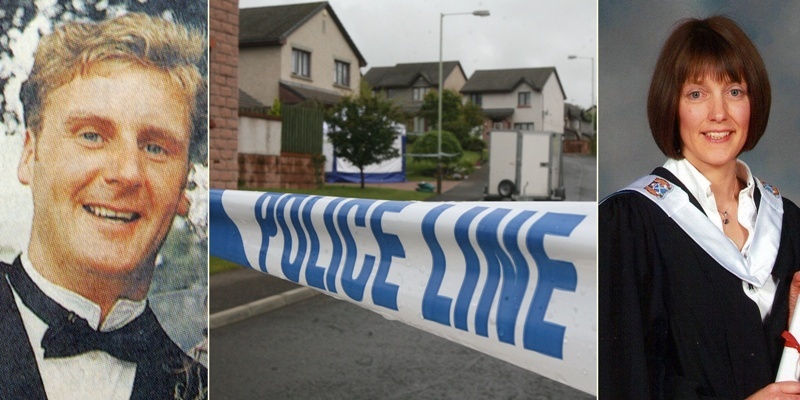A man who stabbed his wife to death in a frenzied attack at their home in Longforgan has been acquitted of murdering her on the grounds that he was insane at the time.
Neil Cumming (46) was ordered to be detained in the state mental hospital at Carstairs with no limit of time.
Cumming stabbed his wife Barbara Jane 36 times. The horrifying attack came a day after he was denied entry to Carseview Hospital in Dundee. He had been deemed low-risk and there were no beds available.
The High Court in Glasgow heard that after the attack he drove on the A90 Perth to Dundee dual carriageway at speeds of more than 100mph before deliberately crashing into the back of a lorry in an attempt to take his own life.
Toxological tests showed he had taken a cocktail of drugs.
Ordering the jury to acquit Cumming of the murder on the grounds that he was suffering from a persistent delusional disorder, Judge Norman Ritchie QC told the court: ”This was an awful tragedy and my heart goes out to the family of Jane Cumming.”
Mrs Cumming worked for Lloyds TSB and after the verdict the company paid tribute to her.
A spokesman said: ”Jane was a very popular colleague and is sorely missed by all who worked with her across Dundee and Perthshire. Our thoughts are with her family and friends during this very difficult time.”
Cumming had been charged with murdering Jane, who was 40 at the time, by repeatedly striking her on the body with a knife at their home in Mary Findlay Drive, Longforgan, on July 15 last year.
The jury was told of the tragic events in a joint minute of agreement of evidence between the Crown and the defence which read: ”On the morning of July 15 2011 Cumming repeatedly struck his wife on the body with a knife, inflicting 36 major stab wounds on her torso, both arms and hands.”
Advocate depute Alex Prentice QC said the Crown was simply dropping the second charge of dangerous driving at speeds of up to 101mph and causing the collision which injured two men.
John Hamilton QC, for Cumming, led no evidence.
He said: ”He is at pains to express publicly that he loved his wife dearly and still can’t understand the events that led to him hurting her,” adding that it was ”the last thing he wanted to do”.
”He is truly sorry for what he has done and he appreciates that it will sound hollow given these tragic events. However, he wants to say sorry to his daughters and hopes they will understand he was ill when he did what he did.
”He also wants to say sorry to both families and thanks them both for their support.”
Judge Ritchie said he would make a compulsion order detaining Cumming in Carstairs Hospital along with a restriction order and special security because of his history.Court hears of mental health concernsThe court heard that Neil and Jane Cumming had been married for 16 years and had two daughters, then aged 11 and 12.
Cumming had been diagnosed with persistent delusional disorder in 1999 when he believed his wife was poisoning him.
He also thought he was being spied on by colleagues at work in the Michelin tyre factory in Dundee.
In February last year he had been admitted to Carseview Mental Health Hospital before being released, with his condition and medication being reviewed.
On Monday July 11 his wife had spoken to Cumming’s community psychiatric nurse over her concerns for his mental state.
The following day the CPN, a Mr Menzies, came to see Cumming and arranged for him to be seen later in the week by a Dr McLaren, who met the couple on Thursday July 14.
Cumming’s ”paranoia was obvious” during this meeting and he was asked if he had ever considered harming himself. He replied that he had not and that he loved his wife and children.
Dr McLaren thought his medication needed to be reviewed and thought it best that was done with the accused being admitted to Carseview, but there were no beds available.
It was decided that the accused would be referred to the Acute Mental Health Response Team who would monitor his condition in the community until a bed became available.
Following the appointment the couple returned to their home of four years. Their children were staying with a relative.
The following day Cumming killed his wife, telling a Carseview nurse who had phoned Jane’s mobile phone that: ”I have committed a terrible crime.”
Asked what he meant, he would only speak about his medication, telling her it had been tampered with and it was ”fake”.
An appointment was made for him to attend at Carseview at 3pm that afternoon, an appointment he never kept.
A neighbour saw him drive away from his home and witnesses then saw the accused using his mobile phone as he drove out of a lay-by at speed, driving erratically through traffic before striking a lorry on the A90.
Cumming was trapped in his car with multiple fractures and abrasions. Firefighters and a trauma team freed him before taking him to Ninewells Hospital in Dundee.
He was unconscious for several days in intensive care.
Once he was deemed well enough, he was arrested and charged and Perth Sheriff Court convened at his hospital bed where he was fully committed for trial.
NHS Tayside responded to the statement made in court that Cumming had been denied access to Carseview as there were no beds available.
Medical Director Dr Andrew Russell said: ”If any patient requires to be detained under the terms of the Mental Health (Care and Treatment) (Scotland) Act 2003 they would always be admitted to a psychiatric in-patient unit.”
